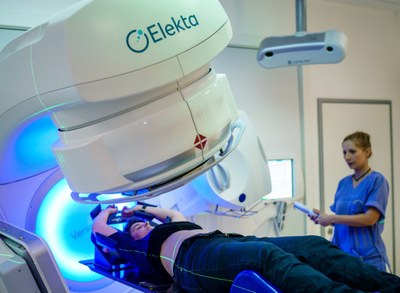Radiation therapy
In recent decades, radiation therapy has undergone rapid development due to technical innovations and has evolved into a high-precision treatment. Modern radiation equipment now makes it possible to irradiate tumors located deep in the body in such a way that neighboring organs are spared as far as possible. To ensure this high degree of targeting accuracy, three-dimensional, computer-assisted radiation planning is carried out in advance, using imaging techniques such as computed tomography (CT), magnetic resonance imaging (MRI) or positron emission tomography (PET) to provide an exact representation of the tumor and the surrounding healthy tissue. The goal of this "local" cancer therapy is to cure the patient, or to alleviate symptoms in the case of advanced disease.

In the inpatient area, the focus is on various combination treatments involving radiotherapy and chemotherapy, as well as on palliative care. In the outpatient area, patients with various types of tumor receive irradiation therapy either on its own or in combination with chemotherapy drugs.
NCT/UCC Dresden provides an excellent framework within which the Clinic and Polyclinic for Radiation Therapy and Radiation Oncology can collaborate with other oncology-oriented clinics of the University Hospital. In addition, the University Hospital is one of the operating partners of the OncoRay - National Center for Radiation Research in Oncology. This makes it possible for scientific results to find their way quickly into clinical application. The combination of state-of-the-art equipment and application of the latest research findings ensures optimal therapy concepts and radiation techniques for patients.
The aim of all staff involved in the treatment process is always to care for the individual patient as a whole person, and to provide them with the best possible therapy on an individual basis (for further information on the radiotherapy process (in German), please refer to the DEGRO brochure "Strahlen für das Leben").


